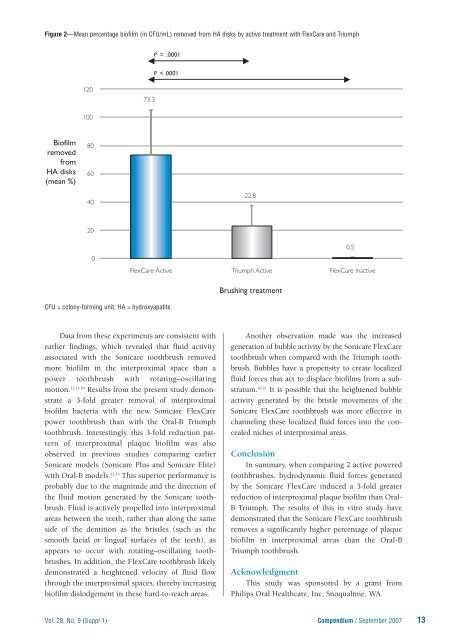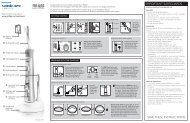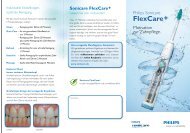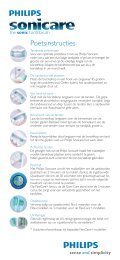Philips Sonicare FlexCare - Sonicare.com - Sonicare
Philips Sonicare FlexCare - Sonicare.com - Sonicare
Philips Sonicare FlexCare - Sonicare.com - Sonicare
Create successful ePaper yourself
Turn your PDF publications into a flip-book with our unique Google optimized e-Paper software.
Figure 2—Mean percentage biofilm (in CFU/mL) removed from HA disks by active treatment with <strong>FlexCare</strong> and Triumph<br />
P = .0001<br />
P < .0001<br />
120<br />
73.3<br />
100<br />
Biofilm<br />
removed<br />
from<br />
HA disks<br />
(mean %)<br />
80<br />
60<br />
40<br />
22.8<br />
20<br />
0<br />
<strong>FlexCare</strong> Active Triumph Active <strong>FlexCare</strong> Inactive<br />
0.5<br />
Brushing treatment<br />
CFU = colony-forming unit; HA = hydroxyapatite.<br />
Data from these experiments are consistent with<br />
earlier findings, which revealed that fluid activity<br />
associated with the <strong>Sonicare</strong> toothbrush removed<br />
more biofilm in the interproximal space than a<br />
power toothbrush with rotating–oscillating<br />
motion. 12,13,18 Results from the present study demonstrate<br />
a 3-fold greater removal of interproximal<br />
biofilm bacteria with the new <strong>Sonicare</strong> <strong>FlexCare</strong><br />
power toothbrush than with the Oral-B Triumph<br />
toothbrush. Interestingly, this 3-fold reduction pattern<br />
of interproximal plaque biofilm was also<br />
observed in previous studies <strong>com</strong>paring earlier<br />
<strong>Sonicare</strong> models (<strong>Sonicare</strong> Plus and <strong>Sonicare</strong> Elite)<br />
with Oral-B models. 12,13 This superior performance is<br />
probably due to the magnitude and the direction of<br />
the fluid motion generated by the <strong>Sonicare</strong> toothbrush.<br />
Fluid is actively propelled into interproximal<br />
areas between the teeth, rather than along the same<br />
side of the dentition as the bristles (such as the<br />
smooth facial or lingual surfaces of the teeth), as<br />
appears to occur with rotating–oscillating toothbrushes.<br />
In addition, the <strong>FlexCare</strong> toothbrush likely<br />
demonstrated a heightened velocity of fluid flow<br />
through the interproximal spaces, thereby increasing<br />
biofilm dislodgement in these hard-to-reach areas.<br />
Another observation made was the increased<br />
generation of bubble activity by the <strong>Sonicare</strong> <strong>FlexCare</strong><br />
toothbrush when <strong>com</strong>pared with the Triumph toothbrush.<br />
Bubbles have a propensity to create localized<br />
fluid forces that act to displace biofilms from a substratum.<br />
19-21 It is possible that the heightened bubble<br />
activity generated by the bristle movements of the<br />
<strong>Sonicare</strong> <strong>FlexCare</strong> toothbrush was more effective in<br />
channeling these localized fluid forces into the concealed<br />
niches of interproximal areas.<br />
Conclusion<br />
In summary, when <strong>com</strong>paring 2 active powered<br />
toothbrushes, hydrodynamic fluid forces generated<br />
by the <strong>Sonicare</strong> <strong>FlexCare</strong> induced a 3-fold greater<br />
reduction of interproximal plaque biofilm than Oral-<br />
B Triumph. The results of this in vitro study have<br />
demonstrated that the <strong>Sonicare</strong> <strong>FlexCare</strong> toothbrush<br />
removes a significantly higher percentage of plaque<br />
biofilm in interproximal areas than the Oral-B<br />
Triumph toothbrush.<br />
Acknowledgment<br />
This study was sponsored by a grant from<br />
<strong>Philips</strong> Oral Healthcare, Inc, Snoqualmie, WA.<br />
Vol. 28, No. 9 (Suppl 1) Compendium / September 2007<br />
13










